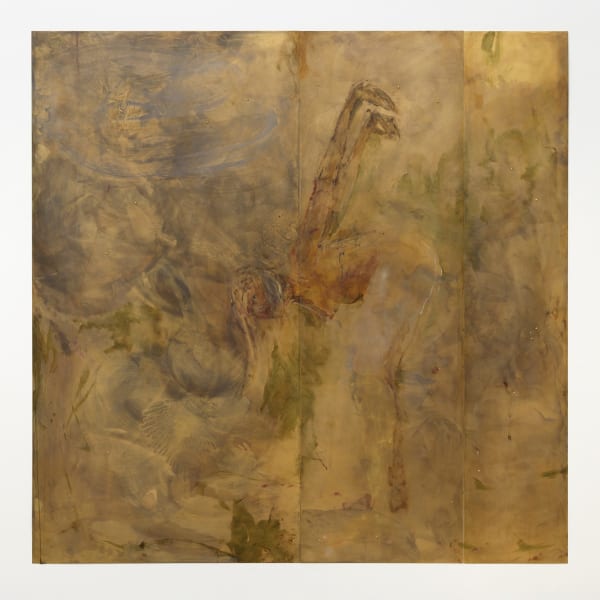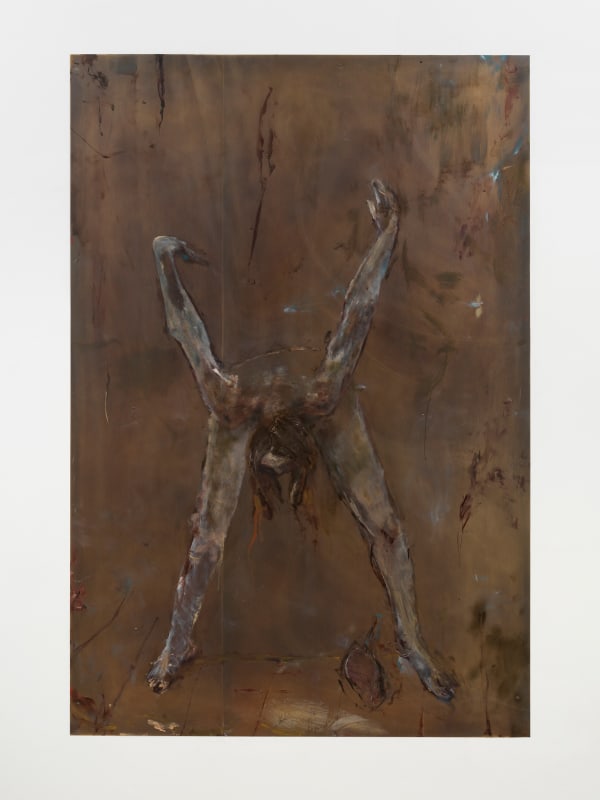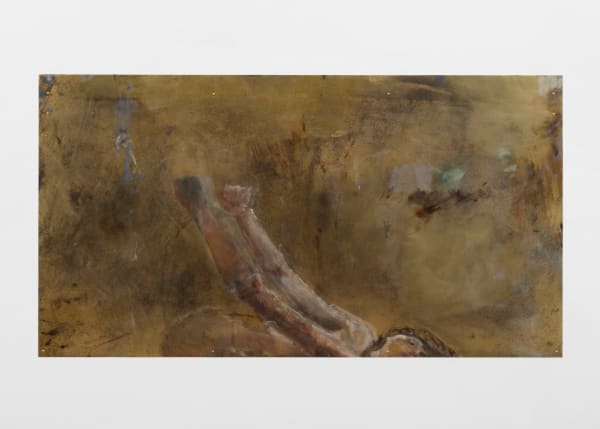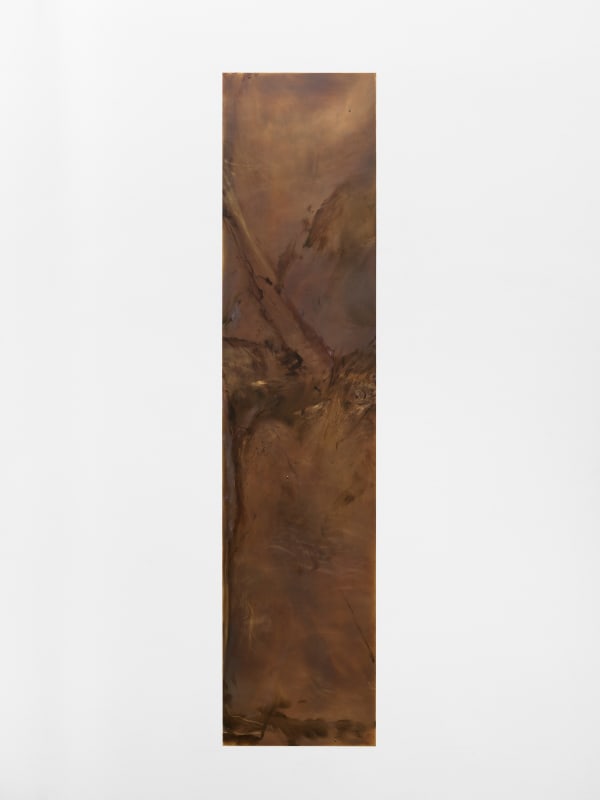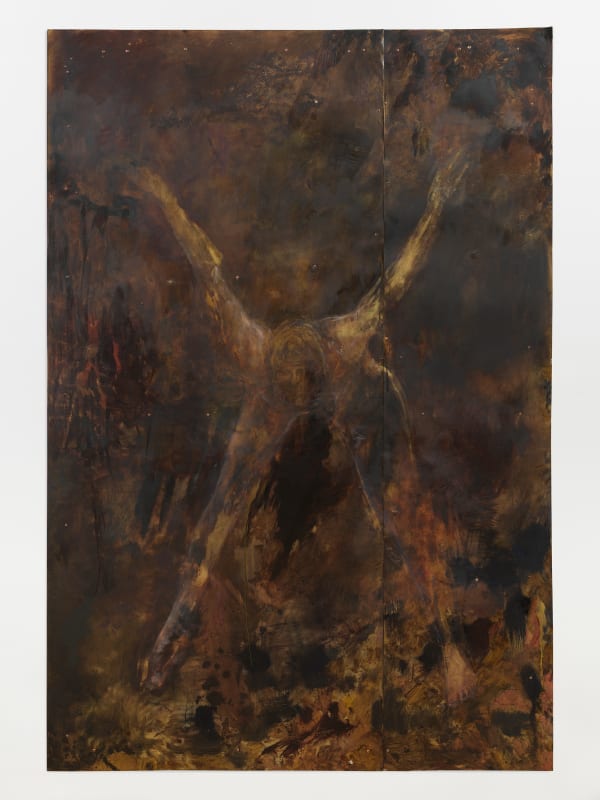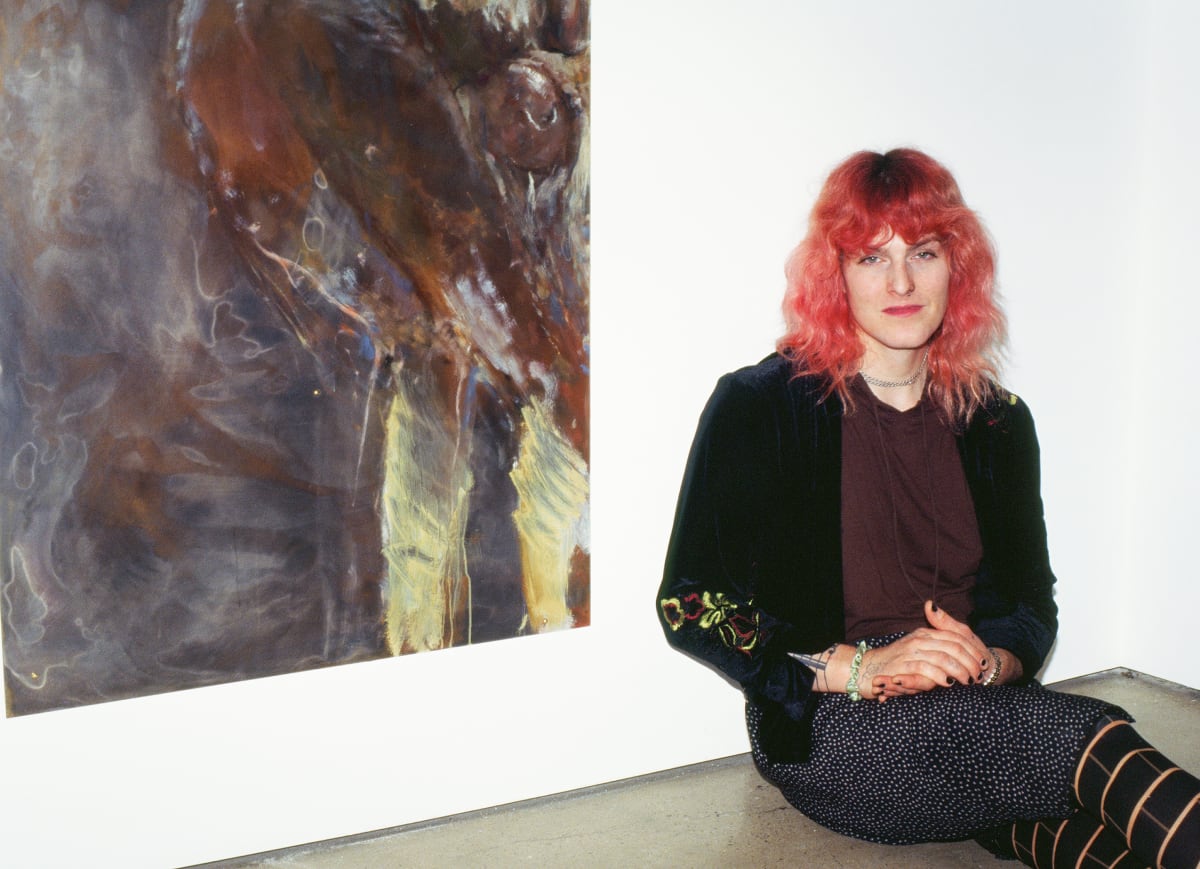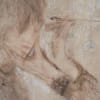Willa Wasserman: Mirror xx,xxx,x
François Ghebaly is pleased to announce the opening of Mirror xx,xxx,x, Willa Wasserman’s second solo exhibition with the gallery, and first time presenting in our New York space.
In Mirror xx,xxx,x, American painter Willa Wasserman presents her newest body of work comprising six paintings in oil and silver nitrate on bronze. Oriented in the gallery space in a panoramic, 360-degree arrangement, the paintings resemble weak mirrors, reflecting just a few feet in front of them. Wasserman’s own figure is depicted in each as though standing at the center of the room, eyecontact unbroken, and with her arms and legs outstretched in a dramatic, authoritative gesture that resembles a cross, an X, a kiss, a chromosome, a bow, or the universal symbol of refusal– ‘no.’
The exhibition’s back room contains a single painting entitled Apple tree gemel (2023), which shows a rare botanical phenomenon of natural fusing or inosculation, when two trees grow together and become one.
Exhibition Notes by Poet and Essayist Kay Gabriel
October 28, 2023
Willa Wasserman’s discomfiting figure haunts her own canvases, these sheets of bronze under patina. Though the paintings aren’t self-portraits, she’s the sitter, rendering herself in a posture that looks either like an X or an animal rushing towards the viewer. It must have been excruciating to hold.
As Wasserman’s titles—“in the shape of an X or a no”—suggest, the shape might stand for abstraction, in an algebraic way, or negation. A figure in pain stands in for something else, or she blocks our path. Standing in for something else is typical of trans figuration—Emma Heaney and Viviane Namaste independently record the ideologically ingrained use of transsexuality as figure for something other than itself, anything at all. Following the logic of the disjunction, on the other hand, the sitter may be assuming the shape of a no. In that case, her negation is not an absence—instead a fleshly, ghoulish obstacle, a doubtful portent, a punk “no.”
Or is she in the shape of a cross? If so, she gestures obliquely towards paintings of crucified thieves, but not salvific ones. Turn the view 90 degrees, and the subject in sideways profile seems instead to be in pain, her back pushed flat like a cutting board and her arms raised behind her as if suspended by invisible ties. What are we witnessing in this position that nobody would normally assume, conveniently rendered for the curious viewer at every angle? Wasserman’s palette, turbid as a Goya, would have matched the haze of obliterated Canadian forest that descended on New York in early June, and turned the sun into a dull suggestion. Her figures seem to have walked out of catastrophe and onto their tarnished surfaces, legs wide and arms aloft.
In 2023, trans women’s self-portraiture—Martine Gutierrez, Nash Glynn, Ser Serpas, Juliana Huxtable, the Greer Lankton renaissance, Pippa Garner’s late celebrity—is God. Transparently, I love this genre to distraction. In a way, its appeal is intuitive. People subjected to unrelenting public scrutiny wrest control of the view; they angle, light and dress themselves, they glower fabulously, they’re astonishing and naked, they rise coolly above it, they’re ironic or aloof and rarely ever tragic. South of self-portraiture, Wasserman’s approach to self-representation strips it of its glamour. The pose she adopts is too awkward even to be unbecoming, and the figure under paint and patina is not recognizable as her. It’s more like a study in the extremity of form, slamming into but not past the point of organic possibility—edging an experience of damage, sometimes seductively so. The multiple angles on the figure stage a confrontation, yes, but in the gallery space, this antagonism goes both ways. A viewer circles the X or no, and the sitter observes you, too, almost readying for a fight.
What of the bronze itself, the metal differently pearlescent, striped, tawny, blooming under chemical exposure like water under algae, and changing over time? Shifting in tandem with the paintings' angle on the sitter in the single pose in a way that canvas couldn’t, Wasserman’s material lends a dynamism and an instability to her study in form, as various and obsessive as a serial poem, and as defiant, too.
– Kay Gabriel
-
 Willa Wasserman, Making the shape of the letter x or 'no' with my body reflected in this north facing mirror version one, 2023
Willa Wasserman, Making the shape of the letter x or 'no' with my body reflected in this north facing mirror version one, 2023 -
 Willa Wasserman, Making the shape of the letter x or 'no' with my body reflected in this northwest facing mirror version five, 2023
Willa Wasserman, Making the shape of the letter x or 'no' with my body reflected in this northwest facing mirror version five, 2023 -
 Willa Wasserman, Making the shape of the letter x or 'no' with my body reflected in this south facing mirror version three, 2023
Willa Wasserman, Making the shape of the letter x or 'no' with my body reflected in this south facing mirror version three, 2023 -
 Willa Wasserman, Making the shape of the letter x or 'no' with my body reflected in this south facing mirror version seven, 2023
Willa Wasserman, Making the shape of the letter x or 'no' with my body reflected in this south facing mirror version seven, 2023 -
 Willa Wasserman, Making the shape of the letter x or 'no' with my body reflected in this northwest facing mirror version three, 2023
Willa Wasserman, Making the shape of the letter x or 'no' with my body reflected in this northwest facing mirror version three, 2023 -
 Willa Wasserman, Making the shape of the letter x or 'no' with my body reflected in this south facing mirror version ten, 2023
Willa Wasserman, Making the shape of the letter x or 'no' with my body reflected in this south facing mirror version ten, 2023 -
 Willa Wasserman, Apple tree gemel, 2023
Willa Wasserman, Apple tree gemel, 2023


